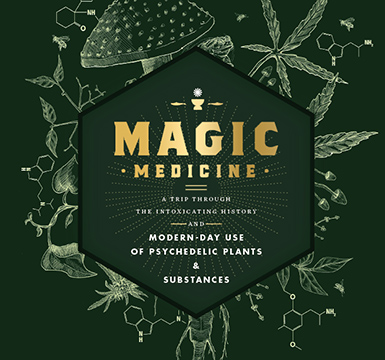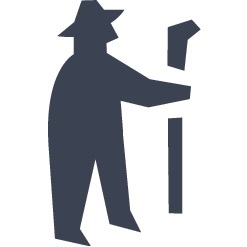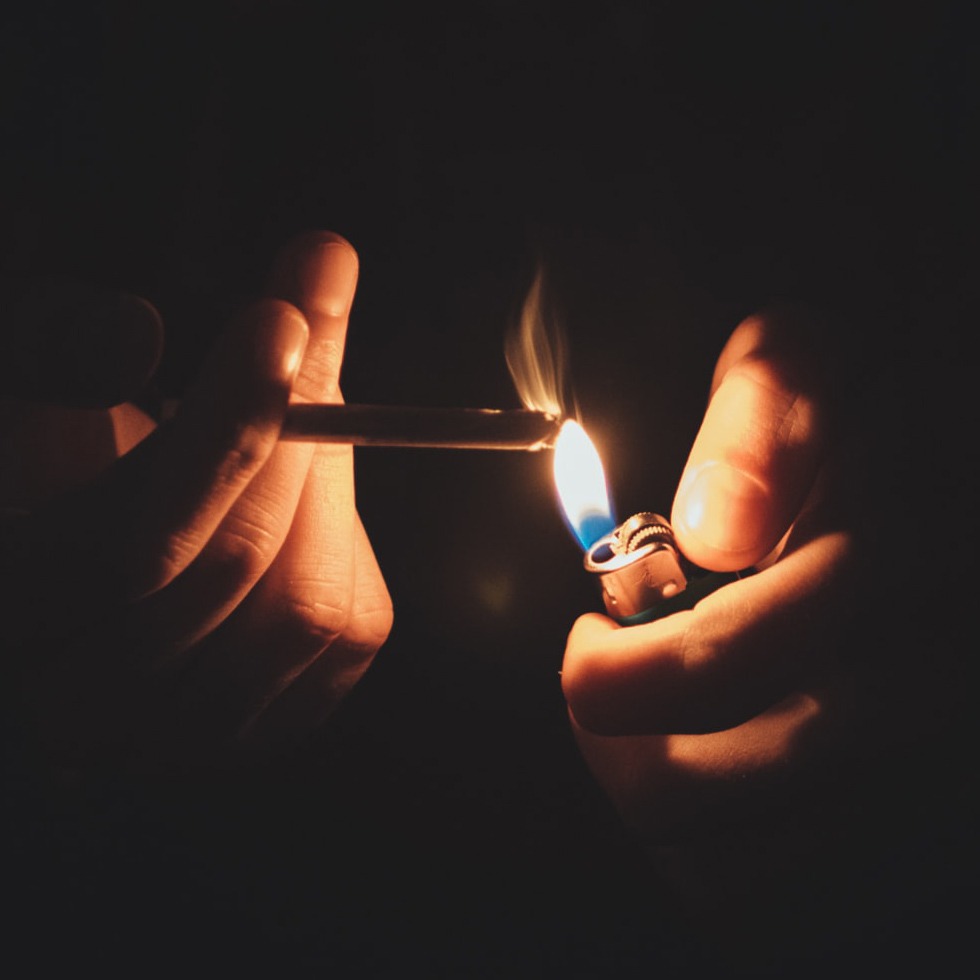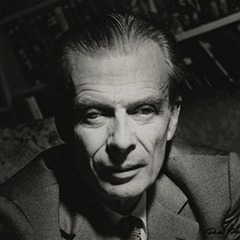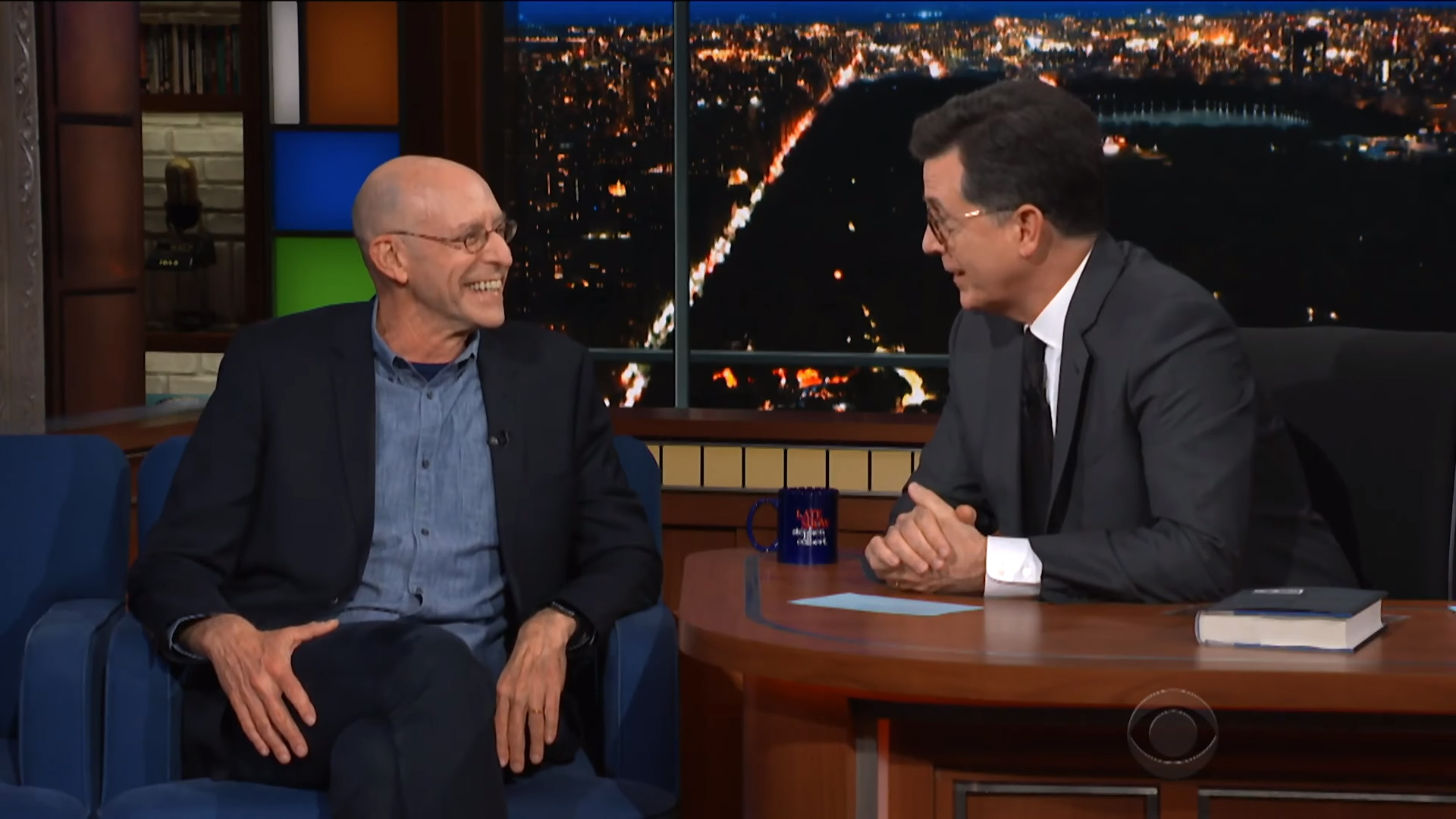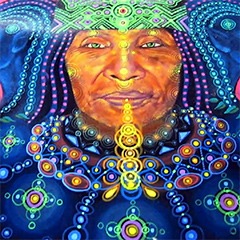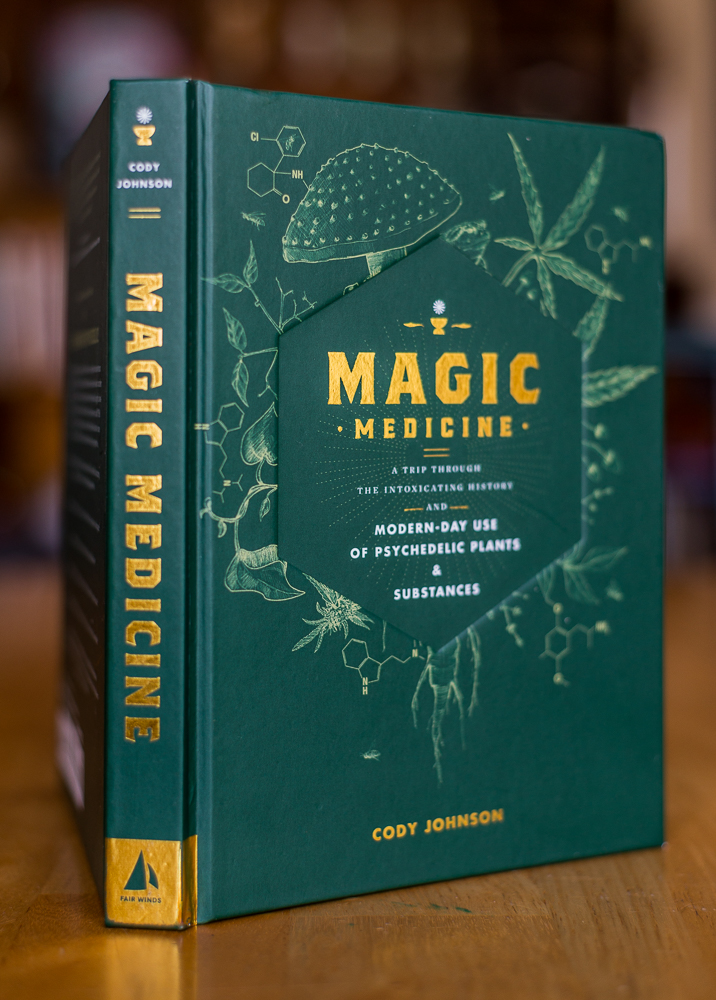Ayahuasca: A Skeptic’s Notes (or The Shortcut to Eternity Leads Through Hell)
by Psychedelic Frontier on Dec 27, 2017 8 Comments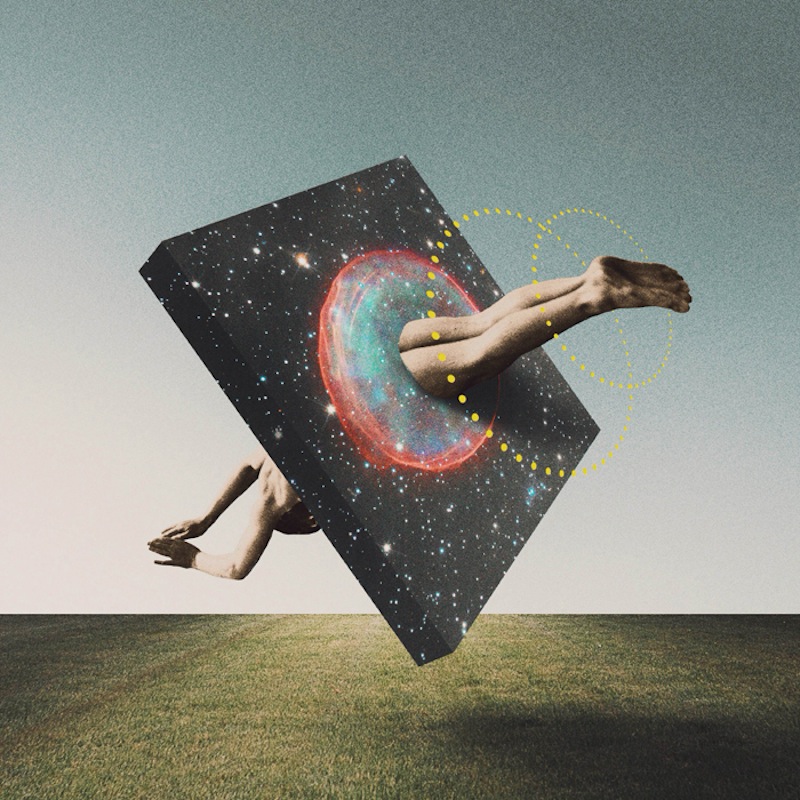
Art by Douglas Hale
Eye-Uh-Waz-Kah
I was drinking coffee in the courtyard of the Los Angeles County Museum of Art when I finally mastered the pronunciation of the word “ayahuasca.”
Redmond Blake, who was sitting across from me in dark shades and a baby blue painter’s jacket, was explaining the Medicine to me. A few days earlier, he’d returned from a weekend-long ayahuasca ceremony in Ojai led by disciples of a powerful shaman from Peru. Under the protection of the Mother, he had taken an astonishing journey through a beautiful and frightening spirit land. As I listened to Red’s stories in the cool shadows of LA palm trees, the earthy fragrance of the ancient tar pits bubbling around us, his words sounded as fantastical and strange as a tale from the Arabian Nights.
On his journey, Red met a goddess that took his hand and propelled him into the heavens. Among pillars of swirling cosmic dust he surveyed the universe and was overwhelmed by the beauty of creation. He soared through illuminated clouds and from these sublime heights he studied the people and places of the life he’d left on earth. When she whispered secret wisdom into his ear he began to feel a deep trust for the will that was within him. The rapture he felt was so profound that he told the goddess he did not want to return to his life on the planet below. But go he must. And his journey down from these heavenly heights was filled with Inferno-like terror. For what seemed like hours, Red encountered demons and shrieking terrors and shivered through a darkness of existential dread. He was certain he would die. But then something wonderful happened: he began to feel deep gratitude and appreciation not just for life, but for his life. And in that moment, Red realized he wanted to return to life.
[pullquotecenter]I was ready to face whatever the medicine showed me, but I didn’t want to experience the kind of existential meltdown that might lead me to quit my job, buy a typewriter, sail to Bali and start a solar powered bike rental company.[/pullquotecenter]
“I don’t think I’ll be the same,” Red concluded. “It was one of the most powerful experiences I’ve had.” I studied Red. I’d known him for almost twenty years and it did seem like there was something different about him. “Do you know anything about ayahuasca?” he asked me.
“Nothing beyond what you’ve just told me and the reference in the Father John Misty song.”
“It’s very special,” Red said.
Most people I know learned the history of ayahuasca from the “banned” Ted Talk by Graham Hancock and rounded out their knowledge by reading pieces in LA Weekly and the New Yorker. In the most popular version of the story, people say there is a special vine in the Amazon rainforest that can induce an otherworldly experience. For millennia, indigenous peoples have prepared a visionary brew called ayahuasca by mixing this vine with the leaves of plants rich in DMT — a powerful hallucinogen related to serotonin. This particular combination of plants slows the metabolization of DMT so that the human body processes it over the course of several hours, instead of being rapidly digested by enzymes in the stomach. The psychedelic effects of ayahuasca include the distortion of visual and auditory senses, along with intense introspection that may lead to joy, terror, or illumination. Historically, ayahuasca has been used for religious and medicinal purposes and some believe that it has the power to reveal cosmic secrets by connecting users to a mysterious goddess called la Madre — the Mother.
But didn’t knowing the template for the trip in advance influence the way it was experienced? “It’s no longer a case of ‘seek and ye shall find,’” I pointed out to Red, “but ‘ye shall find what ye seek.’ If you’d never heard of the Mother, would you still have met her? Wouldn’t it be better to go in without preconceptions?”
I was anticipating the moment when an agent of the universe would whisper sacred and old truths in my ear and unfold the raw nature of existence to me.
“Ever since the ceremony,” Red told me, “I realized that if I allowed myself to be guided by my inner will, if I followed the information of my heart and the curiosities of my spirit, then through that compass I would find purpose. I feel empowered to turn up the volume of the voice of the spirit within me and follow wherever it leads. I’m not afraid to die. I’ve never had any other hallucinogenic experience that brought me closer to spiritual truth or made me feel as inspired.”
“I don’t know,” I said. Although it was obviously a transformative experience for Red, there was a part of me that felt there was something wrong about it, something too good to be true that aroused my skepticism. “It sounds like a shortcut to enlightenment,” I finally said. “And even if you feel temporary clarity, it’s like the difference between climbing to the top of a mountain or taking a helicopter ride there. The view is the same, but at the end of the helicopter you know less about the mountain.”
“You’re wrong,” Red grinned. “It’s more like a rocket ship to Mars than a helicopter ride. Would you rather take a rocket or never see another planet at all?”
When we finished our coffee we went in to see the collection of Medieval European Art that William Randolph Hearst had amassed during his lifetime. I assumed I would never hear about ayahuasca again.
But less than two months later I found myself huddled outside a shaman’s yurt in Sebastopol, sprinkling holy cedar over a crackling fire pit and jotting down weird revelations on scraps of paper.
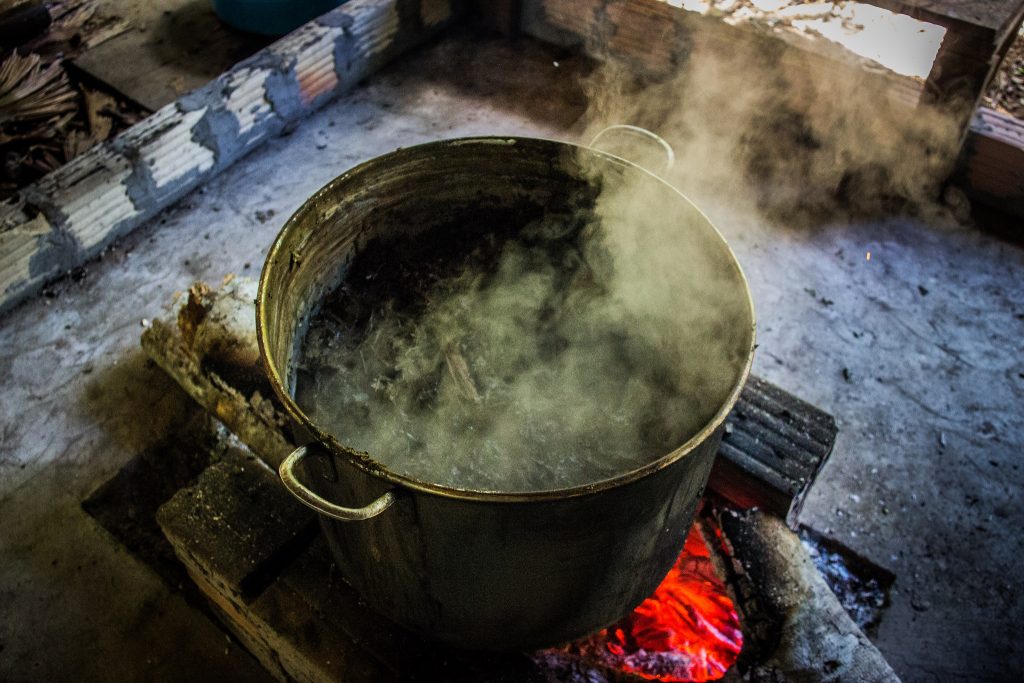
Setting Intentions
Events overtook me; I was carried across the Golden Gate Bridge and into the wooded ravines of Sonoma County with a rush so momentous the whole thing felt predestined.
My path to the ceremony was as circuitous as it was unexpected. I wasn’t even supposed to be there. I initially bought a place for my brother, but then he canceled and another friend agreed to take his place. Two weeks later Red materialized in San Francisco and recounted tales of his journey through the spirit lands and this time I found it so compelling that I agreed to go to the ceremony if he joined too. But then he cancelled a few days later and no one else could go either. By this time, however, I’d already paid money into the shaman’s PayPal account. I’d gone too far to turn back.
In the week leading up to the ceremony I threw myself into the dietary and spiritual preparations with great energy. In strict observance of the no-meat and no-dairy policy, I restricted myself to spinach and kale salads, snacked on almonds and olives, and found ways to introduce quinoa into every meal. My coffee habit was swapped out for Yerba Mate, and I avoided booze.
For me, the most challenging part of the preparation was setting spiritual intentions. The shamans recommended that you identify one thing you wanted to bring into your life, and one thing you wanted to leave behind. After thinking about it for a few days, I decided on the following:
To Call In: I’ve always strived for enlightened skepticism. And while the practice of balanced agnosticism always felt intellectually honest to me, there is a part of myself that suspected it lacked moral courage. I wanted to give myself the space to call belief into my life and take leaps of unconditional faith, no matter how foolish it appeared to myself or others.
To Leave Behind: I’ve never hesitated to use technology or substances to help me become the best version of myself possible. But lately I’d begun to feel like I was incapable of functioning without my smartphone, coffee or alcohol. I did not want to depend on anything outside of myself to function at the highest level possible. I wanted to leave behind dependencies.
It had been over ten years since my last hallucinogenic experience, an uncanny afternoon spent rambling the streets of San Francisco, up Russian Hill and down to North Beach, searching the cobbled alleys for the electric echo of the Beats like a physicist probing the universe for the signature of the Big Bang. I’d been in college during this mushroom-fueled odyssey and this trip was just one part of a greater effort to transcend my middle-class roots and break into the rarefied bohemian lifestyle of my artistic heroes.
Now, however, I was a married professional in my thirties with a job I liked that paid me well and took me around the world doing interesting work. The prospect of deconstructing my life choices and exposing myself to regret made me nervous. I was ready to face whatever the medicine showed me, but I didn’t want to experience the kind of existential meltdown that might lead me to quit my job, buy a typewriter, sail to Bali and start a solar powered bike rental company.
But it’s worth doing something new if you get a good story at the end of it. So I accepted whatever might come and waited for the ceremony with a mix of trepidation and excitement.
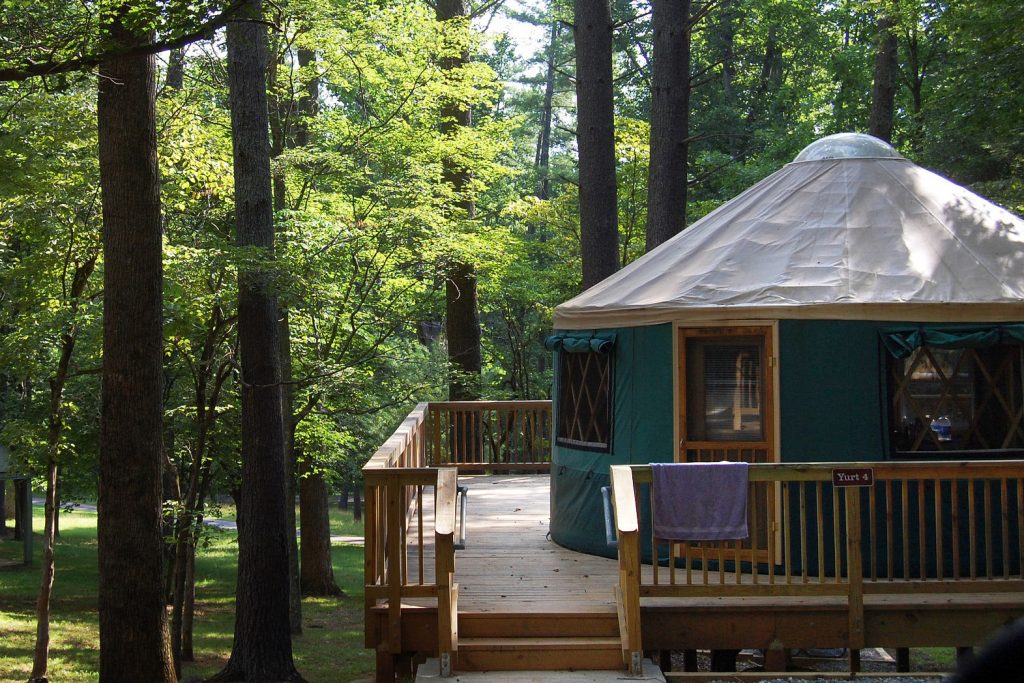
The Road to Sebastopol
The ceremony was on a Friday evening, so I left work early to avoid traffic on the 101 and headed into the city, passed over the Golden Gate Bridge, through Mill Valley and Petaluma, then veered off the main highway into the single-lane country roads that wind through redwood forests and old farmhouses of the North Bay.
Most of the trip I’d been listening to a BBC podcast on Thucydides’ The Peloponnesian War and when it was over I put on Spotify and hit shuffle. The last song that played before I turned onto the private lane was Ceremony, by New Order. It felt like a lucky conclusion to the drive.
It was dark when I parked my car on the gravel driveway of a large and tree-covered property that included a chalet-like house and a large yurt nestled among the dark hills. A man with a beard greeted me by my car and led me towards the entrance of the yurt, where the ceremony would begin in a couple of hours.
Inside, I was expecting to find a culturally diverse group of thirty or so prosperous city liberals from the same casual-enlightenment crowd that I encountered at Yoga classes on weeknights. Instead, there were only six people in the Yurt, all committed hippies of a specific Northern Californian lineage, descendants of the Merry Prankster age that had limped into the modern era. Seated on mats and camping mattresses, they built up pillow fortresses reinforced with wool blankets and fluffy duvets. Most had set up personal altars of sacred objects: crow feathers, crystals and geodes, amethyst fragments, blue and silver rocks, tarot cards, black and white photographs of holy men from centuries past. I nodded at the group as I entered and then set-up my minimalist camp. I had no crystals, no tarot cards, no bundles of sage, no offerings for the gods. All I had was a yoga mat, a thin blanket and a half-charged iPhone without any service.
[pullquoteleft]When the yurt was clouded with smoke and the only light was the flickering glow of the embers in the wood-burning stove, the celebrant poured out the first cup of medicine and invited us to the altar to drink, one by one.[/pullquoteleft]My lack of celestial instruments was not the only thing that set me apart. The other men in the room wore their hair long, either tied up in buns or hanging in matted locks around their shoulders. Their beards flowed wild and free like the hoary facial hair of river deities in the fountains of Rome. They wore billowing white trousers and loose-fitting linen shirts that called to mind the monastic garments of the East. I, on the other hand, was still in my work clothes and was wearing jeans, a thick wool sweater, leather jacket and chukka boots. I’d been travelling a lot for work over the last couple of weeks and was clean shaven with freshly cut hair brushed to the side.
After I took my place, one of the participants came over and welcomed me to the ceremony. He told me that he owned the property and if I needed anything I could ask him. The rest of the group all knew each other, he explained, and were friends of the shamans. This was his third straight weekend taking ayahuasca.
“Have you ever done it?” he asked.
“Never.”
“The shamans say the medicine finds you when you’re ready,” he reflected. “Everything happens for a reason, brother. If you’re here with us tonight it’s because it was meant to be. It’s going to blow your mind. No one is the same after walking with La Madre.” A huge grin curled over his lips, exposing rows of teeth as yellow as the inside of a pumpkin.
“Has it changed you?” I asked.
“I’ve walked with the Mother many times and she always teaches me something new.” There was a dewy freshness in is eyes as he spoke of the Mother, like a newborn calf seeing grass for the first time. “I’m glad that you’re here with us tonight,” he said. “You have good energy. Are you an Aquarius?”
“Unfortunately not,” I replied.
“Too bad. Well, I’ll see you on the other side, brother.”
Although I appreciated his offer of support, our conversation left me uneasy. For someone so devoted to self-examination, he seemed as two-dimensional as a side character in a Charles Dickens novel — more pastiche than person. But maybe he wasn’t problem. Maybe it was me and my habit of passing judgment on everyone I met. Either way, I was beginning to feel like an outsider and I thought maybe I didn’t belong in the yurt in Sebastopol.
The Mother, I Presume?
When the shamans arrived they took their seats on a raised altar beside a sweet-smelling antique stove that burned pine and piñon wood. There were three of them: a soft spoken man in glasses and a First Nations vest, flanked by two women in flowing white dresses with feathers in their hair and strings of ceremonial beads dangling from wool ponchos.
For two hours, we sat in silence while the shamans waited for the favorable astronomical conditions required to open the ceremony. Every few minutes, one of them would leave the yurt to study the skies for omens and then return to the altar to confer gravely with the other shamans. Their seriousness reminded me of the way ancient Romans once studied sacred chickens for divine auspices to guide them in matters of state. When at last the moon and the planets were aligned to their satisfaction, the shamans agreed that the time had come to begin the ceremony.
The lead shaman darkened the room and explained the schedule of the evening’s ceremonies. Over the course of the night and early morning we would cycle through four stages that corresponded to the elements (water, air, fire, earth) and the seasons (spring, summer, fall, winter) and the phases of life (infancy, childhood, adulthood, old age) and the four cardinal directions. While she spoke, the other shamans made a clockwise procession around the yurt, swinging smoking censers to purify the space. Once a thick cloud of incense hung in the cabin, they fanned out ceremonial feathers and beat them in the air and told us that they were welcoming the spirit and this spirit was a kind foreign intelligence that would tell us important truths if we listened.
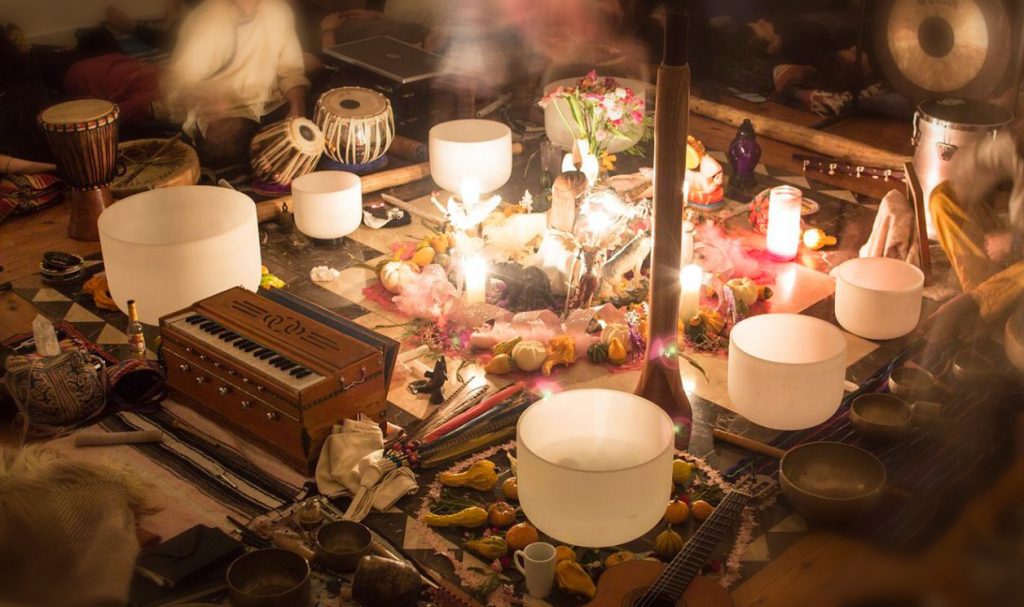
When the yurt was clouded with smoke and the only light was the flickering glow of the embers in the wood-burning stove, the celebrant poured out the first cup of medicine and invited us to the altar to drink, one by one. When it was my turn I went forward and knelt before the shamans. As I swallowed the bitter medicine I remembered everything that Red told me about the cosmic visions of gold and silver and purple and of the uncanny intelligence I would see hidden inside swirling red clouds. I was anticipating the moment when an agent of the universe would whisper sacred and old truths in my ear and unfold the raw nature of existence to me.
All the lights were extinguished and we sat in darkness, waiting for the medicine to take hold. The shamans moved to the middle of the room, where a large statue of Ganesh was standing beside Buddha on a southwestern style rug. They began playing instruments and chanting and soon the yurt was filled with the otherworldly sounds of a harmonium. I closed my eyes for a few minutes and when I reopened them instead of three shamans, I saw nine figures gathered on the altar in the blood-red robes of cardinals. They played a dreamy symphony and their bodies swelled and swayed with the music. The cardinals wore hoods and there was darkness where their faces should have been.
I closed my eyes and I was dropped into a Hieronymus Bosch-like horror show. There were spinning death’s heads and broken wheels and bodies decaying in snow. Embers of funeral pyres glowed in the distance and I knew these were the lights of the city of the dead. My gaze fell on the sagging skin of the corpses. They were cheese-colored and moth-eaten, with purple holes where meat and bone peeked through. There were bodies piled everywhere. It was like walking through a country decimated by plague. But I knew I wasn’t seeing a specific historical episode of mass death; I was staring into the universal meat grinder. It brought to mind the denouement of a frenetic interview Jack Kerouac gave to The Paris Review in 1967 where he retold the life of the Buddha. In a mid-century timbre, Kerouac described the night the Buddha spent in the forest contemplating mortality. When dawn came the Buddha finally understood: the cause of death is life!
‘Why not use our own music, our own icons, our own mythology as the starting point?’ asked the Voice. ‘Wouldn’t you rather be listening to Bach’s organ works or looking at a Mark Rothko painting?’
These scenes disturbed me. In an effort to change the topic, I thought back to my intentions and tried to consider what it would mean to call in belief and leave out dependencies. Then I heard The Voice.
“Okay, pal,” he began. “So you came here thinking your intentions were pretty smart, right? Well, I’m afraid you’ve made some big errors. Belief is the greatest dependency possible. If you want to live life free of dependencies then you must give up belief. Very few things in life are knowable and you’re not in a position to believe anything very firmly. Instead of believing something, take a position and defend it with courage. Evaluate the available positions, pick the most suitable one for your current purpose and when it ceases to have utility, pick again. That’s the only way to live without dependencies.”
I was surprised at how pragmatic The Voice was. I’d been expecting an encounter with a warm and maternal guiding spirit; instead, I found myself listening to the urbane musings of someone or something with a Mephistophelean bent.
“Okay,” the voice continued. “Are we done with the intentions?”
“Sure,” I replied.
“Good. Now take a look at these people dressed in headdresses and pajamas. They came here to indulge in a sanctimonious, greatest-hits version of spirituality that they shamelessly plagiarized from other people’s religions,” I opened my eyes and once more noted the statues of Ganesh and Buddha placed atop a Native American rug. “These so-called shamans appropriated a holy ritual from the rainforest, packaged it up with Buddhist and Hindu branding, and peddled it as a luxury experience to privileged white people on the coasts of America. It’s nauseating when you think about it. We should be learning from indigenous tribes instead of listening to burnouts hold court on religious practices they know nothing about.”
Although there was something mean-spirited in The Voice’s comments, his ruthless deconstruction of the ceremony struck me as being not only funny, but also quite true. I realized I was chuckling to myself.
“And listen to this music,” The Voice continued. He paused long enough for me to take in the droning harmonium and the dreadful pounding of a bongo. Across the yurt, the shamans were chanting something. “That jungle brew turned your mind into a lightning rod and yet here we are, caught in an asinine tableau set to the soundtrack of the Home Furnishings section at Urban Outfitters. If you want the real experience fly to Peru and spend forty-eight hours sweating in the jungle. But as long as we’re here, can’t we just dispense with the costumes and the tribal affectations and take a plunge into something real? And why not use our own music, our own icons, our own mythology as the starting point? Wouldn’t you rather be listening to Bach’s organ works or John Coltrane? Wouldn’t you rather be discussing Thucydides’ Melian Dialogue or looking at a Mark Rothko painting?”
[pullquoteleft]I felt like I had done six months worth of thinking in a handful of hours. It was the cleanest and coldest session of focused introspection I’d ever experienced.[/pullquoteleft]
Almost two hours had passed and some of the other participants were still vomiting into their buckets. Over the guttural heaving, I heard weeping and saw a woman beating her fists on the ground. Two men paced the room in opposite circles. One woman was seated with her hands clasped in prayer before the figurines of gods. The man who owned the yurt was placing crystals around the room, adjusting an invisible energy matrix that only he could see.
When the shamans offered a second cup of medicine I was one of the few that returned for a second dose. I had a feeling that I would not be coming back and I wanted to get as much from the experience as possible.
“Do you feel it,” the soft-spoken man asked as he handed me my second cup. He was surprised by my laughter and told me it was unusual I hadn’t thrown up.
“I feel it,” I answered, “but not the way you do.”
“No one does,” he answered.
When I returned to my mat, I silenced the voice and tuned out the pageantry of the ceremony so that I could turn my thoughts inwards. For the next six hours, I methodically analyzed and addressed every open concern in my mental life. The topics rolled through one by one, like items in an assembly line. Many subjects were put into the bucket of things that are unknowable and unalterable (mortality, the Fermi paradox, is the universe a simulation?) and everything that remained was studied and assigned an actionable next step. For elderly grandparents, I planned visits and eulogies. A new dietary regime was fixed and rules for alcohol consumption were put in place. Timetables were drafted for major life decisions (children, mortgages, investments), and time was earmarked for passions. In the end, I felt like I had done six months worth of thinking in a handful of hours. It was the cleanest and coldest session of focused introspection I’d ever experienced.
The last topic addressed was ayahuasca itself. This was a powerful substance but it was over-hyped and badly branded, misused and misrepresented. The spiritual aspect of it was so nebulous that it was basically meaningless for anyone that lacked credulity. If you could get beyond these trappings and use it scientifically ayahuasca could be a powerful tool for self-examination and creative inspiration. This ceremony, however, felt like a farce put on by well-intentioned charlatans. I only began deriving value from it once I was able to ignore them.
For a long time, I hadn’t paid attention to what anyone else in the yurt was doing. When I became aware of my surroundings, I noticed that most of the others were lying down, asleep or whimpering. I slipped outside of the yurt and sat down beside a fire pit that one of the female shamans had been tending for most of the night. It felt good to be outdoors, breathing the crisp mountain air, listening to the crackling of the fire and glimpsing light from distant stars and planets that had travelled so long to reach us.
When I returned to the yurt everyone was sleeping. Even the shamans had put away their metaphysical instruments and crawled under their faux-Navajo blankets.
Recalled to Life
I woke up at 11am with a clear head and a strong desire to go back to San Francisco and get to work.
Out of a mixture of politeness and a budding anthropological interest, I remained for another hour to participate in the closing ceremony. The lead shaman produced an egg shaped crystal from his vest and passed it around the circle. The person holding the crystal had the floor and was encouraged to share their experience with the medicine. People spoke of trauma and revelation and childhood memories and dreams of the future with a freewheeling candor I found admirable but impossible to replicate. When it was my turn I thanked them for welcoming me to their group and passed the egg to my neighbor.
Fifteen minutes later I was speeding through the redwood forest and I felt liberated and relieved and thankful the experience was over and I was freed from the purgatory of the ceremony.
After twenty miles I came to an opening in the forest with a diner and a gas station and I pulled off the road for a coffee. When the waitress passed my cup across the counter our fingertips touched and for a moment I felt that something was different. In 1624 John Donne heard the sound of funeral bells tolling for the dead and the sound of these bells reminded him of his involvement in mankind. When I heard the clatter of plates and the muffled voices in the diner I had the same feeling. Some people were dying and some people were being born and some people were making good things. Whatever happened, we all belonged to the same species and lived on the earth and inhabited the same island of time. Together we were traveling to a place that nobody understood and it was the journey that connected us.
Driving my car, drinking my coffee, everything was glorious and when I sped through the burnt orange pillars of the Golden Gate and saw the sun move over the face of the waters I felt that I’d returned to life. And it was good.
![]()
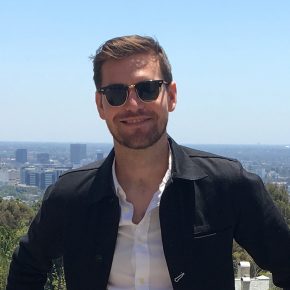 Dalston Playfair lives in San Francisco and works in the tech industry. Prior to that, he spent several years working in the publishing industry in London after graduating from Trinity College, Dublin, with a Master’s degree in Comparative Literature. You can follow with on Medium here: https://medium.com/@
Dalston Playfair lives in San Francisco and works in the tech industry. Prior to that, he spent several years working in the publishing industry in London after graduating from Trinity College, Dublin, with a Master’s degree in Comparative Literature. You can follow with on Medium here: https://medium.com/@
Liked this post? Subscribe to my RSS feed to get much more!

